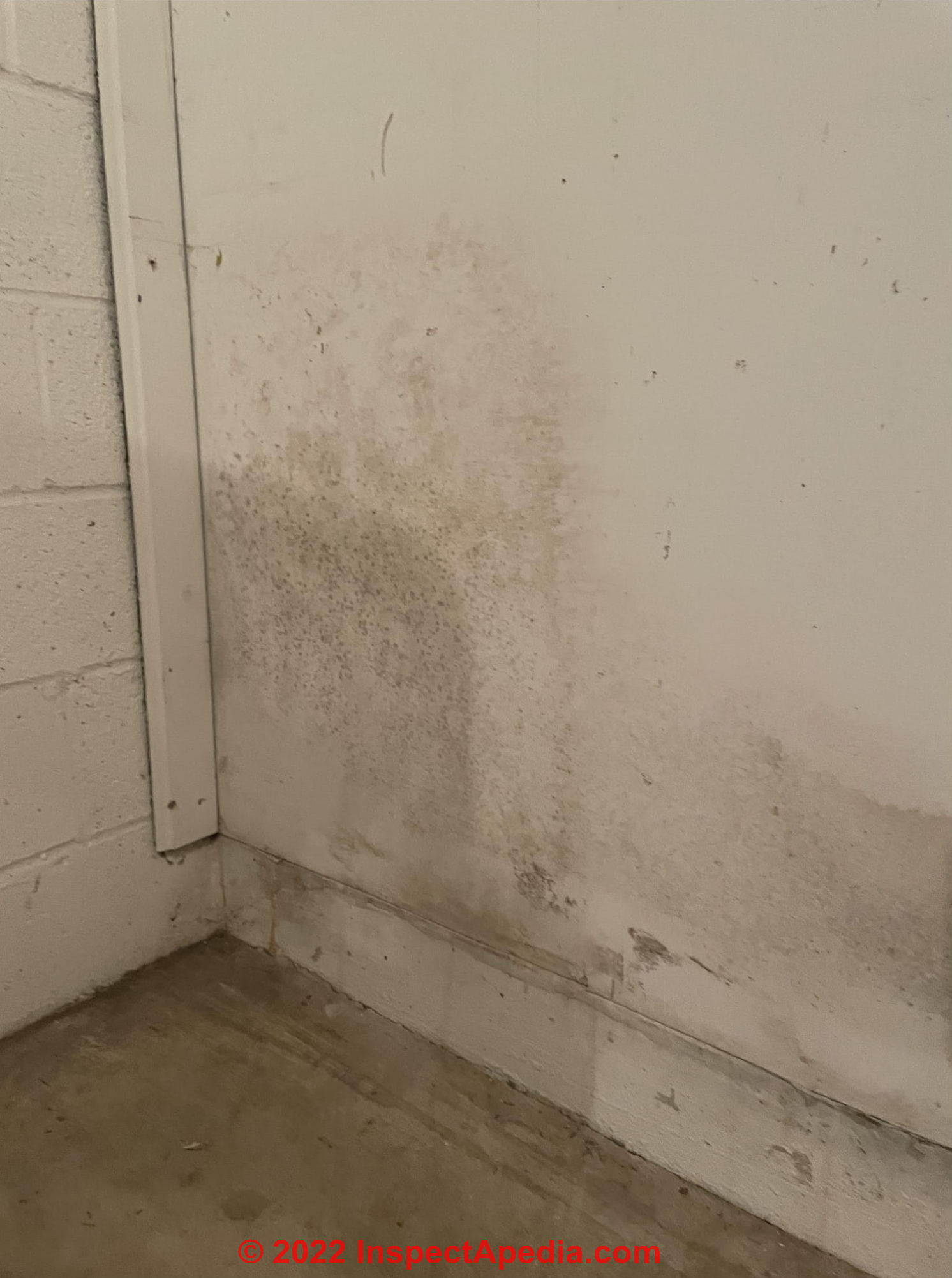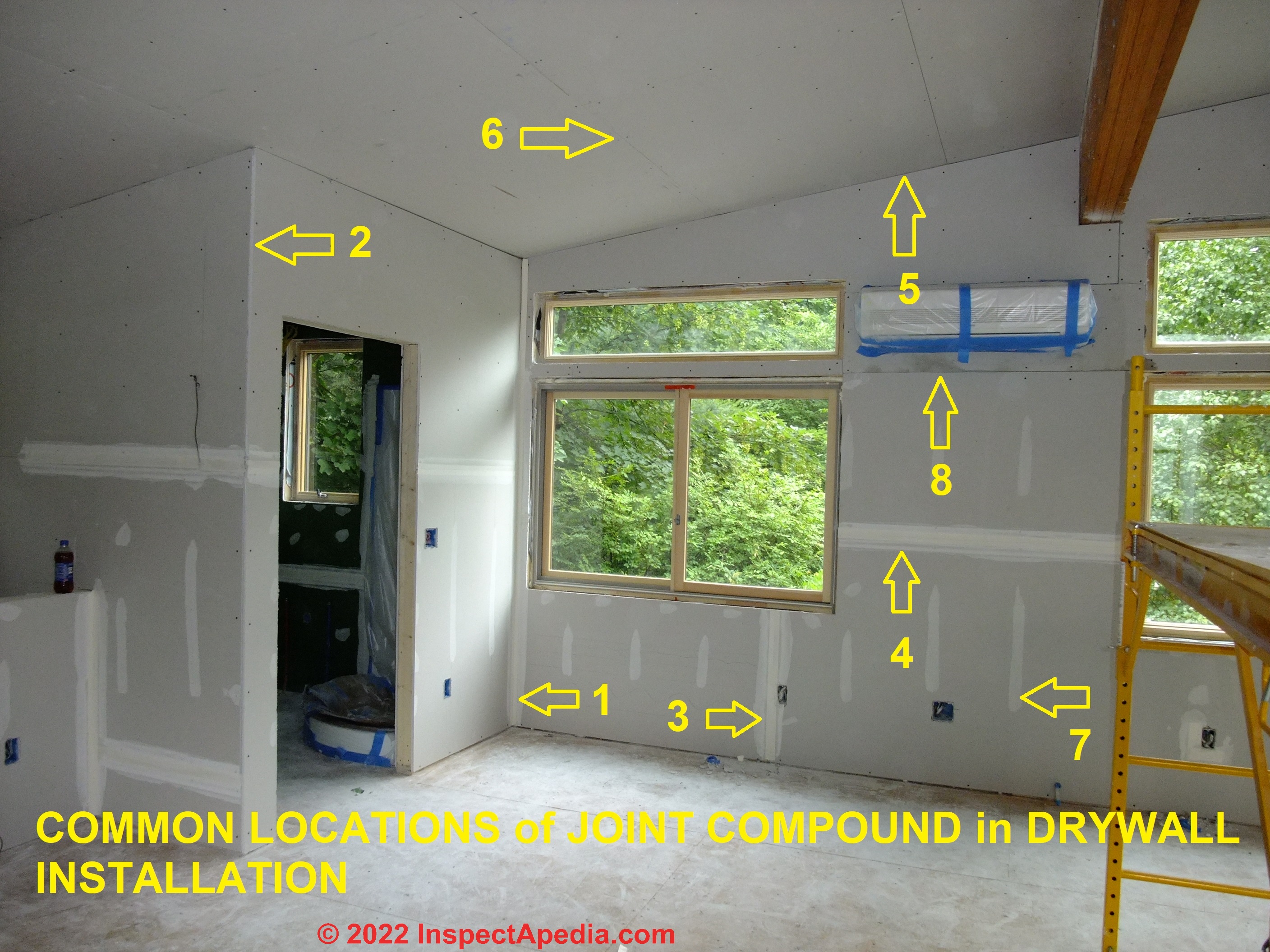 Where to Test for Asbestos in Drywall Mud
Where to Test for Asbestos in Drywall Mud
Sampling Locations for Joint Compound Asbestos Testing
- POST a QUESTION or COMMENT about asbestos in drywall joint compound and test locations for drywall mud
Asbestos was an ingredient used in some older drywall mud products.
If we want to collect test samples to have our drywall joint compound ("drywall mud") tested for asbestos, how do we know exactly where to collect the samples?
Here we illustrate the best drywall sampling locations if you need to test the joint compound itself for asbestos.
This article series explains where asbestos is likely to be found in gypsum board or drywall systems, particularly in the taping compound and in skim coats using drywall "mud" that contained asbestos.
InspectAPedia tolerates no conflicts of interest. We have no relationship with advertisers, products, or services discussed at this website.
- Daniel Friedman, Publisher/Editor/Author - See WHO ARE WE?
Test Locations for Asbestos in Drywall Joint Compound
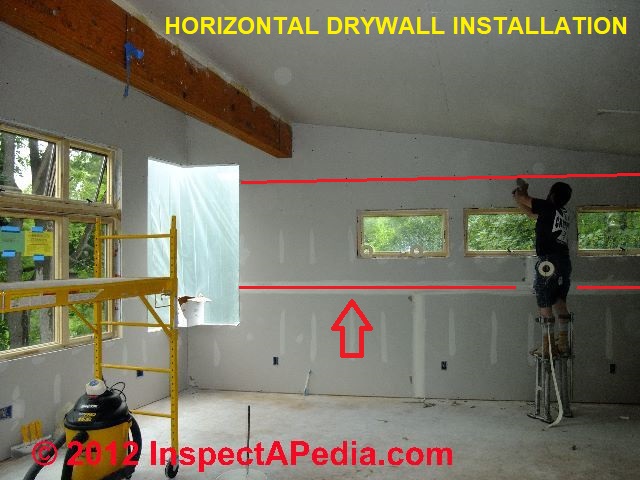 Modern drywall and taping compound do not contain asbestos.
Modern drywall and taping compound do not contain asbestos.
But if drywall or gypsum board or "Sheetrock®" was installed in your building in North America between the late 1920s and 1980 it is possible that the drywall or the joint compound used on the drywall contains asbestos.
Not all drywall sold during those years contains asbestos, and it's less commonly-found in residential applications.
Keep in mind that asbestos content in most materials is not harmful if it is covered and /or otherwise left un-disturbed.
So you can avoid a hazard by avoiding creating a dusty mess.
[Click to enlarge any image]
Drywall or "joint compound" asbestos content: on older buildings may contain asbestos fibers. Asbestos was [probably] universally used in drywall joint compound prior to the early 1980's.
Here we discuss asbestos-test-sample locations for drywall mud.
For a complete explanation of the potential asbestos hazard in drywall products, see
ASBESTOS in DRYWALL - home.
Where To Collect Joint Compound Samples to Test for Asbestos
How can I figure out where to collect samples of drywall mud to test for asbestos?
An InspectApedia reader asked:
I read the website and cannot find the answer to this question.
I know nothing.
We need to remove some drywall from our 1970 built house for a plumbing repair. I read online that joint compound may contain asbestos.
How can i figure out where the seams or joint compound would be in order to take a sample?
If there is asbestos in that compound, would removing a few pieces of drywall to do the repair and renovation be a very hazardous thing?
We already know the drywall itself does not have asbestos. - Anonymous by private email 2022/09/27
Here are the 8 Most-Likely Places to Find Joint Compound on Wall or Ceiling Drywall
Moderator reply: I have marked on our photo [shown above] the eight most-common locations where a drywall hanger would have applied joint compound or "drywall mud".
In locating drywall seams where drywall mud (joint compound) will have been used, usually along with mesh or paper tape, it's helpful to understand that drywall is sold in North America in sections that are
- 4' x 8'
- 4' x 10'
- 4' x 12'
and that conventional building wood or steel stud framing is typically 16" on-center or 24" o.c. - so drywall fasteners and joints will occur over those framing members as will screws or nails to secure the drywall in place over its body.
- Inside wall corner.
It is almost impossible to finish a drywall installation without taping and applying joint compound (drywall mud) in an inside corner.
This is probably your first choice as most-reliable and easiest to find.
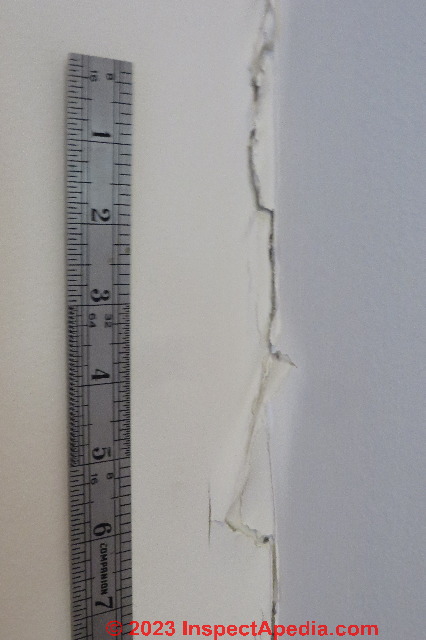
Our drywall corner above shows tearing in the corner caused by movement in the supporting foundation.
For asbestos test sampling, collect a joint compound sample close to or right in the inside corner. - Outside wall corner
Drywall mud is also used, along with paper tape or a metal or plastic corner bead, at outside corners.
Collect a joint compound sample about 1 1/2 to 2" from the outside edge of the corner. - Eight feet from an inside or outside wall corner
Eight feet from the starting inside or outside wall corner is likely to find a butt joint between two sheets of drywall regardless of whether the drywall ("Sheetrock®") was hung horizontally (as in our photo above) or vertically. - Four feet from the floor
IF the drywall was hung horizontally, as is current "best practice" then the next vertical drywall joint or seam will be four feet from the floor. - Ceiling-wall joint
As with an inside or outside wall corner, the ceiling-wall drywall joint will have been taped and coated with drywall mud
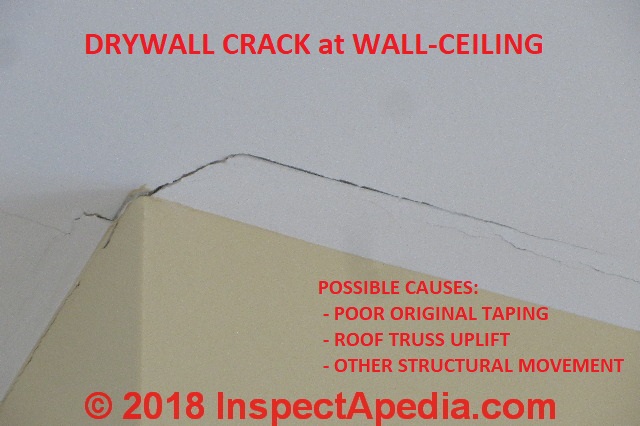
Our photo above shows minor cracking at the taped joint of a wall-to-ceiling. - Four or eight feet along the ceiling from a ceiling-wall joint
Depending on the direction in which drywall was applied to the ceiling you'll find a drywall joint four or eight feet away from a ceiling-wall joint at one side or the other side of the ceiling. - At drywall nail or screws in studs or ceiling rafters/joists
A much smaller quantity of drywall mud or joint compound will have been applied to cover the recessed drywall nails or screws used to fasten the drywall in place.
If your building's walls and ceilings are framed with wood studs or rafters (or the floor joists forming the ceiling if there is another floor overhead) are framed to conventional standards these members will be 16-inches on-center or in some construction, 24" on center.
But you won't know the exact spacing of the drywall screws or nails along those lines.
How to find the drywall screw or nail locations:
you could use a stud finder to locate studs and even a stud finder or metal detector to locate drywall screw or nails to within one-inch.
But frankly because much less joint compound is used in these locations than in corners and at the butt-joints of drywall sections, collecting drywall joint compound (mud) samples from these smaller locations is probably not worth-while.
If the drywall finishing work is imperfect, OR if the building is an older one that has had cycles of moisture and temperature variation, you may spot depressions in the surface marking drywall screws or nails, or you may actually see drywall nail pops.
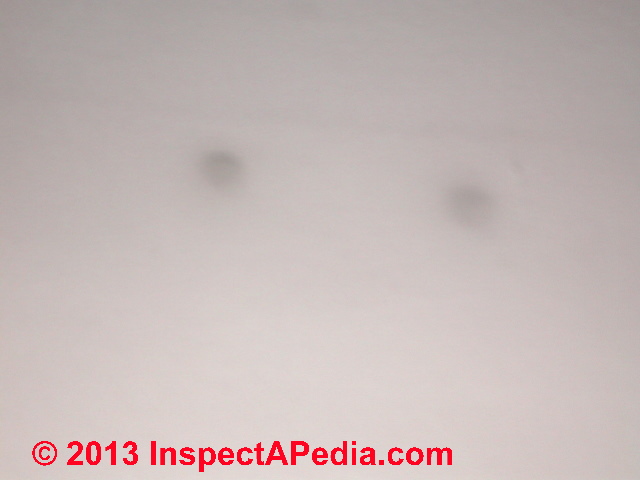
Look for dents or depressions that are 16" or 24" on center and found in lines, or look for dark spots that may be left by thermal tracking marking drywall nails or screws, as we illustrate just above.
THERMAL TRACKING BRIDGING GHOSTING explains the drywall nail-locating soot spots shown above.
Just below is an open drywall nail pop in drywall characteristic of material movement.

The drywall nail pops shown above are explained
at DRYWALL NAIL POPS & DENTS - Eight feet above the floor
In rooms whose ceilings are more than eight feet above the original subfloor, you will usually find a drywall seam eight feet above the original subfloor, or roughly 7 ft. 11 1/2 " above the finished floor.
Really? Well not always. Drywall can be purchased in longer lengths of 10 feet or 12-feet.
...
Reader Comments, Questions & Answers About The Article Above
Below you will find questions and answers previously posted on this page at its page bottom reader comment box.
Reader Q&A - also see RECOMMENDED ARTICLES & FAQs
On 2024-08-30 by AC What's a safe way to just cover-over asbestos-suspect drywall walls and ceilings?
We're fixing up an old rental house that my elder family members once owned where it looks like the seams of the walls have been very messily caulked and/or mudded over in various places, leaving bumpy piles of old gunk at the corners of walls and near the ceilings.
It's so unsightly to paint over, and I'm assuming there's asbestos there since these are the original 1955 walls.
Is there any way to repair or cover this up safely, or does everything have to be gutted and new drywall put up?
Thanks.Reply by InspectApedia Publisher (mod)
@AC,
There are a couple of different approaches to this question.
1. If the walls are not insulated, or if you need to run wires, pipes, etc. then it may be worth pulling down the old ugly messy drywall job to gain access for that other work.
Otherwise, if you don't have other reasons to want to open the walls, then we have two choices:L
2. Skim coat the ugly work with joint compound, using a wide 12" or 14" drywall knife going about 18" wide over each bad drywall seam - that's what I'd do
OR if the walls are in such bad shape that you'd be coating the whole wall, then
3. It may be less costly, faster, safer, to simply install a thin veneer of 1/4" thick drywall over the interior walls.
For this case you'll need to remove all switch and receptacle plate covers and similar wall mounted stuff, add the drywall, then reinstall the switch and receptacle cover plates. To be meticulously code compliant you may need to add electrical box cover plate extenders such as the HUBBELL KILLARK Gasket: Neoprene, Gray, For Use With Hubbell 2F Series Box Covers, FSRG -
Daniel
On 2024-08-30 y jennifer - A pipe broke, we had wet drywall, asbestos tests and abatement done by same contractor who owns the lab: was there fraud?
We had a pipe burst in our home it was built in 1960 and a survey report and scope was done fraudulent.
The certified asbestos technician was not the one who took samples and did not ever come into our home. the samples he said to have taken were place into a ziploc bag and the samples and said area he took could not have been valid because of different flooring. the flooring came back pos and the joint compound.
They removed and should have not disturbed the area.. Should i assume that since the report was done false do you think the results were as well? The abatement charges were 9,491.00 and did not do any of what was invoiced and it took 12 days.
The said workers i cannot verify to proper accreditation to remove and or handle asbestos. they did not get paid and are now suing us for work never needing to be done and we had to be relocated for 3 months.
I never initiated contact with them i guess they came from mitigation company and now the fraudelent inspector also owns the laoratory. very very shady and i believe they all run a scam and know each other.
Reply by InspectApedia Publisher (mod)
@jennifer,
You have our sympathy for what sounds like a stressful and troubling asbestos hazard and cleanup and testing mix-up.
From just your note I am not confident that I fully understand what happened, but let me try to offer a few comments that may be helpful and you can ask follow-up questions or post more information.
First: If the flooring or drywall samples collected in your home were not even from the correct work area then either
1. the on-site work was in my opinion incompetent
or
2. someone (you need to identify who that was) directed the on-site person to the wrong area
Now if you have an asbestos test report on materials that were not in the area needing work (flood damage repair) then while it might not be quite right to call the report deliberately fraudulent, the test and report were certainly improper and incompetent, and they were not performed on the necessary areas.
So in my OPINION your reluctance to pay for that report is reasonable (unless it was you who directed the onsite test person to the wrong area).
Separately from testing for asbestos, if the water damage (and perhaps asbestos debris cleanup work) repairs were not on the area that was the target of necessary work then that work was in error and I can understand your reluctance to pay for it.
A salient question is how was it that the work was done on the wrong area? Who was directing the job? That's the person responsible.
Was that you as homeowner, your insurance company, an independent adjuster or whom. The person directing the work is responsible to see that the work is done properly and in the right building areas.
Finally, and with reluctance, you may have to get help from a local attorney who is familiar with flood damage repairs and environmental hazard testing. Particularly if the amount of the claim is more than would be handled in small claims court (where you might represent yoruself) that's the case.
Was your insurance company involved in this process?
Does your state or province have an asbestos remediation and flood/water damage remediation licensing department? If so, contact them and ask their advice.
Finally, I am not so troubled by an environmental test lab who also has their own inspectors: it's often the case that a lab might have inspectors to provide on-site testing support, and I'd expect such inspectors to be competent.
But in my OPINION it is a serious conflict of interest for a company to offer lab and testing services that result in telling you that work is needed on your home, and then to offer to perform that work.
You're welcome to print this conversation to include with information in your discussion with the people involved.
Daniel Friedman
Is it safe to remove wallpaper from asbestos-containing drywall / joint compound?
Reader follow-up to the question that prompted the article above on this page:
... this answer was extremely helpful and I feel embarrassed for my delay in replying. I ask your forgiveness for my rudeness.
May I ask a follow up question?
We tested drywall mud and unfortunately one of two locations came back positive. The positive sample was in the garage. The sample in our master closet was not positive.
We are now going under the assumption that any of the drywall mud in our house COULD have asbestos in it.
Here are my questions:
1. We wish to remove wallpaper from drywall
elsewhere in our house. We will be removing from walls that were not tested for asbestos in the drywall mud.
There is wallpaper on many walls in our house so it would be a large job to test every wall before wallpaper removal. We believe that the wallpaper was placed over a painted wall but at this point we do not know.
Should we assume that removing wallpaper will not disturb drywall mud enough to be an asbestos concern? And does this answer change if the wall under the wallpaper is painted or not?
2. Inconsistent asbestos test results for drywall mud:
Does it seem odd based on your experience that the drywall mud in our unfinished garage is positive but not in a closet in our house?
The house was built in 1970. I am wondering if we should be optimistic that other areas in the interior of our hose are not asbestos positive in the drywall mud.
Thank you in advance for any thoughts and thank you for your kind service in providing all this helpful information online. - Anonymous 2022/10/19
Moderator Reply:
Given the vagaries of drywall mud and board sampling it's no surprise to get varied results.
Just removing wallpaper e.g. by steaming or wetting wallpaper from the surface of painted drywall ought to be very low risk.
Reader follow-Up:
We are going to remove the wallpaper and then have it painted. Does that change your answer at all?
Again I know very little and not sure if that means alot of sanding or scraping and now at risk etc once the painting is to be done.
Moderator reply: don't sand asbestos-suspect drywall/mud, clean & seal
I would NOT sand the wall or ceiling surfaces without presuming that the dust may contain asbestos.
In my OPINION there's no way to assure, based on a few samples, that asbestos-containing joint compound (mud) isn't present at other locations on your walls and ceilings.
I suspect you can remove the wallpaper, use water to dissolve the wallpaper paste, then apply a coat or two of sealant primer and the walls can be painted with any finish coating you like.
See details at
ASBESTOS ENCAPSULANTS & SEALERS
Reader follow-up:
I had no idea this existed! Your website provides tremendous value, thank you.
To be sure I am understanding correctly, the premise is remove wallpaper and glue with steam or water etc. Then apply sealant primer (rather then sanding) and finish with any normal painting coating desired?
Moderator Reply: prepping asbestos-suspect drywall for painting
Right, that was my suggestion. I have found and removing wallpaper that if you just peel it off it leaves a rough adhesive surface on the wall but usually if you wet that material with water or steam it most of that will come off.
The sealant paint that I've recommended is thick enough in body that it should leave a smooth surface.
If you then paint the walls using any typical interior latex paint and a roller, even a short nap roller, the slight texture given by that application should look fine.
I'd like to see photos of the wallpaper showing its condition and photos of the wall when you have removed the wallpaper and before you've painted.
Watch out: if there were leaks in wall or ceiling cavities it's quite possible that the back side of that drywall is a mold palace.
Leaving any of that material in place would be a big mistake. You would be leaving a mold Reservoir in the building that won't bother occupants and could make someone sick.
Reader follow-Up:
I do not follow entirely the last line. What material are you referencing leaving in place?
Also how would be know if there are leaks in walls or ceiling cavities once the wallpaper is removed? Would that obvious?
Moderator reply: don't sand asbestos-suspect drywall/mud, clean & seal
I'm referring to the possibility that if there have been leaks inside of a wall cavity there can be a hidden mold Reservoir therein. You never want to just paint over moldy wall surfaces. It's a separate topic for me asbestos question
Reader follow-Up: don't just paint over moldy drywall
Got it, so if we see mold on the drywall. Stop and investigate and do not just paint over it. If you do not see mold when the wallpaper is removed then you are good to paint it. That is my takeaway. Please let me know if I am misunderstanding the advice.
I apologize to bother you with another email. This is a matter of intense concern for me so if there is anyway you could have the patience to guide me on a related matter to my previous questions, I would greatly appreciate it.
We tested for asbestos in the drywall in part because we found a possible mold area in the home we moved into and may need to take down the wall to treat it. We tested both the drywall and the compound and the compound came back positive.
I have attached pictures of the possible mold. This was an area that was covered up by a cabinet that was bolted into the drywall for the last 20+ years. It was in our garage and there is no evidence of mold in areas other then where the cabinet was attached to the wall.
I also see no signs of water staining or active moisture. We had a few mold abatement companies come over and look at it and they suggest an expensive course of removing the drywall and various treatments. This cost is compounded if we hire a seperate asbestos abatement company to properly remove the wall first given the positive asbestos sample.
Here is my question...
One person (who was selling asbestos not mold services) mentioned that he thinks it looks like surface mold because its a humid garage without AC. He said anytime something is leaning up against a wall, it can cause mold. I believe he also said it looked old.
He suggested just spraying it with treatment instead of taking down the wall.
I know nothing but if i had to guess I would guess its very old mold and not active, looks more like a stain then a fuzzy mold etc.
It would help my anxiety (and cost) if I could just treat and spray this mold rather then take down the wall. Others have advised that I must take down the wall to find the true cause of the mold.
Do you think just spraying it and watching to see if it comes back or grows is a good course of action? - Anonymous 2022/10/26
Mod:
Surface spraying is not a useful solution. .
Asbestos drywall removal people and methods ought to be fine for removing moldy drywall too.
Reader follow-Up: how much drywall to remove & where might asbestos-containing drywall mud be absent?
Should I expect to find drywall compound on the bottom portion of the drywall?
Where it touches the floor of the garage? If not maybe can get lucky and cut a section that does not have compound.
Mod:
The only joint compound that you'll expect to find at the drywall bottom edge at a floor would be
- repairing gouges or damage that would be visible, perhaps where it'd extend above the floor-wall baseboard trim
- at drywall screws or nails that were spackled-over, again, particularly if they'd have shown above the floor-wall baseboard trim.
On 2022-11-04 by JA - this asbestos is causing me great anxiety
JA's follow-up:
I am sorry to bother you but this asbestos is causing me great anxiety and I was hoping you could give me advice on one additional aspect.
As a refresher, we have moldy drywall in our garage where a cabinet was pushed against the wall. The mold looks to be old and very light. It is on a wall that tested positive for asbestos in the drywall compound. I am hiring a asbestos abatement company to remove the drywall.To lessen my anxiety, it would be great if I could remove the drywall and replace with a new piece in one day.
When we remove the drywall, will it be obvious if there is moisture or mold behind the wall?
As in i should leave it open for awhile to investigate prior to just replacing the piece?
We see no signs of active moisture on the drywall. Another option is I could cut a hole in an area of the drywall that does not impact the drywall mud and investigate what it looks like prior to the asbestos company showing up.
I am frankly not sure what i should be looking for... Thank you
Reply by InspectApedia (Editor) (mod)
@JA (by email),
There's no reason that single section of drywall couldn't be removed and replaced in minutes to an hour of work;
While the wall is open, LOOK
1. at the back of the removed drywall: was it moldy? If so, and if mold extends to the drywall edges, I'd investigate adjoining drywall with some small test cuts - 4" x 2" is usually enough - in the most-suspect areas.
2. in the wall cavity for signs of water or mold - if found, remove any insulation that has been wet, clean the exposed surfaces, add a fungicidal sealant if you want, then restore the wall.
3. be sure you know where water came from and where it went - so that you know where to investigate for hidden mold or other water-related damage.
Let's not have to do the job twice.
Try to relax against your anxiety - that's likely to be more harmful than the moldy drywall and it can also lead to over-spending and possibly un-necessary expense.On 2023-02-08 by Reader JA (mod)
Update: additional correspondence with reader JA about the question/discussion above on this page, starting at this heading:
Reader follow-up: is it safe to remove wallpaper from asbestos-containing drywall / joint compound?
2022/10/26 JA said
Joe A <captcooker72@gmail.com>
Attachments
Oct 26, 2022, 7:40 PM
to me
I apologize to bother you with another email. This is a matter of intense concern for me so if there is anyway you could have the patience to guide me on a related matter to my previous questions, I would greatly appreciate it.
We tested for asbestos in the drywall in part because we found a possible mold area in the home we moved into and may need to take down the wall to treat it. We tested both the drywall and the compound and the compound came back positive.
I have attached pictures of the possible mold. This was an area that was covered up by a cabinet that was bolted into the drywall for the last 20+ years. It was in our garage and there is no evidence of mold in areas other then where the cabinet was attached to the wall.I also see no signs of water staining or active moisture. We had a few mold abatement companies come over and look at it and they suggest an expensive course of removing the drywall and various treatments. This cost is compounded if we hire a seperate asbestos abatement company to properly remove the wall first given the positive asbestos sample.
Here is my question...
One person (who was selling asbestos not mold services) mentioned that he thinks it looks like surface mold because its a humid garage without AC. He said anytime something is leaning up against a wall, it can cause mold. I believe he also said it looked old. He suggested just spraying it with treatment instead of taking down the wall.
I know nothing but if i had to guess I would guess its very old mold and not active, looks more like a stain then a fuzzy mold etc.
It would help my anxiety (and cost) if I could just treat and spray this mold rather then take down the wall. Others have advised that I must take down the wall to find the true cause of the mold.
Do you think just spraying it and watching to see if it comes back or grows is a good course of action?
On 2023-02-08 by Reader JA
@InspectApedia (Editor),
This is helpful perspective. Thank you. I have been struggling through this and your unbiased help has been a blessing. Thank you.The next development is that we found a painter willing to follow your instructions for wallpaper removal without sanding. As they are removing the glue, it has pulled up some of the paint that was under the wallpaper. This has left the wall not as smooth as hoped in some areas. The painter has applied a thick primer to the walls but it is not as smooth as needed.
The painter would now like to apply plaster to the walls and sand this plaster. I do not think they will sand it below the plaster and through the primer they just applied. I will note we used regular primer, not asbestos encapsulation.
Do you see any problem with sanding plaster if our concern is not disturbing joint compound under the primer that may have asbestos in it.Reply by InspectApedia Publisher (mod)
@Reader JA,
That sounds perfectly reasonable
Drywall & Drywall Mud Test Results for Asbestos came back yes for the mud, no for the drywall
@inspectapedia.com.moderator, Thank you for your informative feedback. Apologies for any confusion with my original description and questions.
When the walls were tested by a certified asbestos tester, the drywall was tested separately from the joint compound/wall texture. - On 2021-06-01 by Michelle
The drywall came back negative for asbestos.
The joint compound came back positive, originally for 1-3%.
We had a point sample test conducted to get a more accurate number and the joint compound has .6% asbestos.
My concern is heightened because the joint compound was applied not only to the seams between the drywall sheets, but also to create what is called a knockdown texture over all the interior walls.
It looks almost like a low relief stucco.
We would like to be able to comfortably live in the house, for instance hanging artwork or shelves and anchoring furniture, and also safely live in the house without creating any health hazards.
The house is older and in need of updates such as electrical work installing additional outlets, upgrading wiring, adding and changing out lighting. - Michelle On 2021-06-01
Reply by inspectapedia.com.moderator (mod) - asbestos found not in the drywall but in the joint compound
@Michelle,
In sum the EPA suggestions we cited before are appropriate for the home you describe.
In my opinion there is no detectable asbestos hazard from tapping a nail through tape into drywall that in turn contains a fraction of a percent of abestos.
In my opinion there are potential health hazards from drywall dust, with or without asbestos (it's a respiratory irritant) if produced by doing demolition, power sawing, other activities producing a lot of dust.
When I work on such walls I use a drywall knife to make cuts - minimizing dust, I damp wipe, HEPA vac, wear appropriate PPE, etc. but I do not panic about the hazard.(Panic is very bad for your health and safety as well as your wallet).
In my OPINION and part of the formation also of my views on this matter , it's worth noting that while mesothelioma is a horrible asbestos-caused disease, if we except a few bizarre cases (workers bringing home asbestos) there are few or no documented cases of building occupants developing mesothelioma from residential exposure (such as in the case you describe).
If one reads the history of the workers who most-suffered from mesothelioma (asbestos-caused, serious lung illness and cancers), those unfortunates worked, for example, in the ship-building industry (where asbestos fire-insulation was sprayed over many surfaces) and where workers described the work environment as - paraphrasing:
"The air was actually opaque with heavy levels airborne asbestos dust, so much that sometimes it was hard to see; thick dust covered our clothes, faces, and got in our hair."
Hammering in a nail or even driving a screw (which releases a bit more dust and debris) into drywall is not going to cause that condition in a home.
The EPA and other sources are right to advise people to be cautious. You just cannot imagine all the crazy things people do with asbestos materials and that might create a hazard.
One of my clients who had me test her home for asbestos, was a home seller whose heating pipes were covered with asbestos paper and lagging insulation.She said her husband, anticipating a resale-issue around asbestos, decided to do his own asbestos removal as hiring a pro was expensive. My client (the wife) told me that hubby dragged asbestos insulation up out of the basement and through the house, leaving trails of white debris on carpets and white dust on furniture.
This unfortunate couple created an asbestos dust contamination issue that required that the whole house be professionally cleaned.The ultimate home cleanup cost a lot more than would have been the cost had a qualified, licensed, expert asbestos removal company been hired to do the asbestos removal job in the first place.
How much asbestos was used in drywall or joint compounds?
Do you have any idea how much asbestos was used in drywall or joint compounds? - On 2021-03-23
by Mary
Reply - by (mod) -
@Mary,
The level of asbestos in drywall ranges from none to just a few percent
and
the level of asbestos used in joint compound was also zero to about 5 percent by weight.
see
- ASBESTOS CONTAINING COMPOUND in WALLBOARD [PFD] (2000) Washington State Department of Labor & Industries, WISHA, WISHA Policy & Technical Services at P.O. Box 44648 USA, Tel: (360)902-5503. DOSH Website (http://www.lni.wa.gov/Safety-health/). - retrieved 2021/03/24 original source: https://www.lni.wa.gov/dA/fe0b92a166/WRD2330.pdf
...
Continue reading at ASBESTOS in DRYWALL TAPE? or select a topic from the closely-related articles below, or see the complete ARTICLE INDEX.
Or see these
Recommended Articles
- ASBESTOS CEMENT CEILING & WALL PANELS
- ASBESTOS in DRYWALL
- ASBESTOS in DRYWALL MUD - TEST LOCATIONS
- ASBESTOS in DRYWALL TAPE?
- ASBESTOS-DRYWALL REMEDIATION / REMOVAL
- ASBESTOS in PLASTER - what about the use of asbestos in plaster walls & ceilings?
- ASBESTOS PRODUCING COMPANIES & TRUSTS - complete list includes all asbestos-containing drywall producing companies
- DRYWALL INSTALLATION Best Practices
- DRYWALL INSTALLATION HORIZONTAL vs VERTICAL
- DRYWALL MOLD TESTING
Suggested citation for this web page
ASBESTOS in DRYWALL MUD - TEST LOCATIONS at InspectApedia.com - online encyclopedia of building & environmental inspection, testing, diagnosis, repair, & problem prevention advice.
Or see this
INDEX to RELATED ARTICLES: ARTICLE INDEX to ASBESTOS HAZARDS
Or use the SEARCH BOX found below to Ask a Question or Search InspectApedia
Ask a Question or Search InspectApedia
Try the search box just below, or if you prefer, post a question or comment in the Comments box below and we will respond promptly.
Search the InspectApedia website
Note: appearance of your Comment below may be delayed: if your comment contains an image, photograph, web link, or text that looks to the software as if it might be a web link, your posting will appear after it has been approved by a moderator. Apologies for the delay.
Only one image can be added per comment but you can post as many comments, and therefore images, as you like.
You will not receive a notification when a response to your question has been posted.
Please bookmark this page to make it easy for you to check back for our response.
IF above you see "Comment Form is loading comments..." then COMMENT BOX - countable.ca / bawkbox.com IS NOT WORKING.
In any case you are welcome to send an email directly to us at InspectApedia.com at editor@inspectApedia.com
We'll reply to you directly. Please help us help you by noting, in your email, the URL of the InspectApedia page where you wanted to comment.
Citations & References
In addition to any citations in the article above, a full list is available on request.
- In addition to citations & references found in this article, see the research citations given at the end of the related articles found at our suggested
CONTINUE READING or RECOMMENDED ARTICLES.
- Carson, Dunlop & Associates Ltd., 120 Carlton Street Suite 407, Toronto ON M5A 4K2. Tel: (416) 964-9415 1-800-268-7070 Email: info@carsondunlop.com. Alan Carson is a past president of ASHI, the American Society of Home Inspectors.
Thanks to Alan Carson and Bob Dunlop, for permission for InspectAPedia to use text excerpts from The HOME REFERENCE BOOK - the Encyclopedia of Homes and to use illustrations from The ILLUSTRATED HOME .
Carson Dunlop Associates provides extensive home inspection education and report writing material. In gratitude we provide links to tsome Carson Dunlop Associates products and services.


